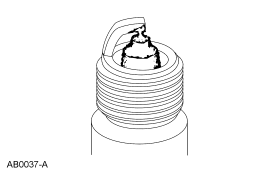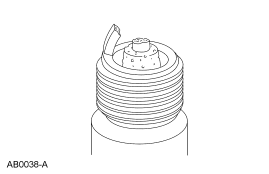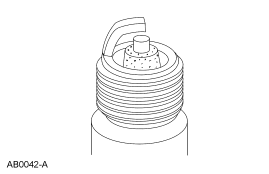Some info on the LS ETC
The Gen 2 Electronic Throttle Control system uses a strategy that delivers output shaft torque, based on driver
demand, utilizing an electronically controlled throttle body. Gen 2 ETC strategy was developed mainly to improve
fuel economy. This is possible by decoupling throttle angle (produces engine torque) from pedal position (driver
demand). This allows the powertrain control strategy to optimize fuel control and transmission shift schedules
while delivering the requested wheel torque. Gen 2 ETC is being introduced on the 2003 MY Lincoln LS and Ford
Thunderbird
View attachment 828573627
Because safety is a major concern with ETC systems, a complex safety monitor strategy (hardware and
software) was developed. The monitor system is distributed across two processors: the main powertrain control
processor and a monitoring processor called an Enhanced-Quizzer (E-Quizzer) processor.
The primary monitoring function is performed by the Independent Plausibility Check (IPC) software, which resides
on the main processor. It is responsible for determining the driver-demanded torque and comparing it to an
estimate of the actual torque delivered. If the generated torque exceeds driver demand by specified amount, the
IPC takes appropriate mitigating action.
Since the IPC and main controls share the same processor, they are subject to a number of potential, commonfailure
modes. Therefore, the E-Quizzer processor was added to redundantly monitor selected PCM inputs and to
act as an intelligent watchdog and monitor the performance of the IPC and the main processor. If it determines
that the IPC function is impaired in any way, it takes appropriate Failure Mode and Effects Management (FMEM)
actions.
ETC System Failure Mode and Effects Management:
Effect Failure Mode
No Effect on Driveability A loss of redundancy or loss of a non-critical input could result in a fault that does not affect
driveability. The ETC light will turn on, but the throttle control and torque control systems will
function normally.
Disable Speed Control If certain failures are detected, speed control will be disabled. Throttle control and torque
control will continue to function normally.
RPM Guard w/ Pedal
Follower
In this mode, torque control is disabled due to the loss of a critical sensor or PCM fault. The
throttle is controlled in pedal-follower mode as a function of the pedal position sensor input
only. A maximum allowed RPM is determined based on pedal position (RPM Guard.) If the
actual RPM exceeds this limit, spark and fuel are used to bring the RPM below the limit. The
ETC light and the MIL are turned on in this mode and a P2106 is set. EGR, VCT, and IMRC
outputs are set to default values.
RPM Guard w/ Default
Throttle
In this mode, the throttle plate control is disabled due to the loss of Throttle Position, the
Throttle Plate Position Controller, or other major Electronic Throttle Body fault. A default
command is sent to the TPPC, or the H-bridge is disabled. Depending on the fault detected,
the throttle plate is controlled or springs to the default (limp home) position. A maximum
allowed RPM is determined based on pedal position (RPM Guard.) If the actual RPM
exceeds this limit, spark and fuel are used to bring the RPM below the limit. The ETC light
and the MIL are turned on in this mode and a P2110 is set. EGR, VCT, and IMRC outputs
are set to default values.
RPM Guard w/ Forced
High Idle
This mode is caused by the loss of 2 or 3 pedal position sensor inputs due to sensor, wiring,
or PCM faults. The system is unable to determine driver demand, and the throttle is controlled
to a fixed high idle airflow. There is no response to the driver input. The maximum allowed
RPM is a fixed value (RPM Guard.) If the actual RPM exceeds this limit, spark and fuel are
used to bring the RPM below the limit. The ETC light and the MIL are turned on in this mode
and a P2104 is set. EGR, VCT, and IMRC outputs are set to default values.
Shutdown If a significant processor fault is detected, the monitor will force vehicle shutdown by disabling
all fuel injectors. The ETC light and the MIL are turned on in this mode and a P2105 is set.
Note: ETC illuminates or displays a message on the message center immediately, MIL
illuminates after 2 driving cycles
Electronic Throttle Monitor
Electronic Throttle Monitor Operation:
DTCs P0606 - PCM processor failure (MIL, ETC light)
P2106 – ETC FMEM – forced limited power; sensor fault: MAF, one TP, CKP, TSS,
OSS, stuck throttle, throttle actuator circuit fault (MIL, ETC light)
P2110 – ETC FMEM – forced limited rpm; two TPs failed; TPPC detected fault (MIL,
ETC light)
P2104 – ETC FMEM – forced idle, two or three pedal sensors failed (MIL, ETC light)
P2105 – ETC FMEM – forced engine shutdown; EQuizzer detected fault (MIL, ETC
light)
U0300 – ETC software version mismatch, IPC, EQuizzer or TPPC (MIL, ETC light)
Monitor execution Continuous
Monitor Sequence None
Sensors OK not applicable
Monitoring Duration < 1 seconds to register a malfunction
Accelerator and Throttle Position Sensor Inputs
Accelerator Pedal Position Sensor Check Operation:
DTCs P2122, P2123 – APP D circuit continuity (ETC light, non-MIL)
P2121 – APP D range/performance (ETC light, non-MIL)
P2138 – APP D / APP E correlation (ETC light, non-MIL)
P2127, P2128 – APP E circuit continuity (ETC light, non-MIL)
P2126 – APP E range/performance (ETC light, non-MIL)
P2140 – APP E / APP F correlation (ETC light, non-MIL)
P2132, P2133 – APP F circuit continuity (ETC light, non-MIL)
P2131 – APP F range/performance (ETC light, non-MIL)
P2139 – APP D / APP F correlation (ETC light, non-MIL)
Monitor execution continuous
Monitor Sequence none
Sensors OK not applicable
Monitoring Duration < 1 seconds to register a malfunction
APP sensor check malfunction thresholds:
Circuit continuity - Voltage < 0.25 volts or voltage > 4.75 volts
Correlation and range/performance – sensor disagreement between processors (PCM and EQuizzer)
Throttle Position Sensor Check Operation:
DTCs P0122, P0123 – TP A circuit continuity (MIL, ETC light)
P0121 – TP A range/performance (non-MIL)
P2135 – TP A / TP B correlation (ETC light, non-MIL)
P0222, P0223 – TP B circuit continuity (MIL, ETC light)
P0221 – TP B range/performance (non-MIL)
Monitor execution Continuous
Monitor Sequence None
Sensors OK not applicable
Monitoring Duration < 1 seconds to register a malfunction
TP sensor check malfunction thresholds:
Circuit continuity - Voltage < 0.25 volts or voltage > 4.75 volts
Correlation and range/performance – sensor disagreement between processors (PCM and EQuizzer), TP
inconsistent with TPPC throttle plate position
Throttle Plate Position Controller (TPPC) Outputs
The purpose of the TPPC is to control the throttle position to the desired throttle angle. It is a separate chip
embedded in the PCM. The desired angle is communicated from the main CPU via a 312.5 Hz duty cycle signal.
The TPPC interprets the duty cycle signal as follows:
0% <= DC < 5% - Out of range, limp home default position.
5% <= DC < 6% - Commanded default position, closed.
6% <= DC < 7% - Commanded default position. Used for key-on, engine off.
7% <= DC < 10% - Closed against hard-stop. Used to learn zero throttle angle position (hard-stop) after
key-up
10% <= DC <=92% - Normal operation, between 0 degrees (hard-stop) and 82%, 10% duty cycle = 0
degrees throttle angle, 92% duty cycle = 82 degrees throttle angle.
92% < DC <= 96% - Wide Open Throttle, 82 to 86 degrees throttle angle.
96% < DC <= 100% - Out of Range, limp home default position
The desired angle is relative to the hard-stop angle. The hard-stop angle is learned during each key-up process
before the main CPU requests the throttle plate to be closed against the hard-stop. The output of the TPPC is a
voltage request to the H-driver (also in PCM). The H driver is capable of positive or negative voltage to the
Electronic Throttle Body Motor.
Throttle Plate Controller Check Operation:
DTCs P2107 – processor test (MIL)
P2111 – throttle actuator system stuck open (MIL,)
P2112 – throttle actuator system stuck closed (MIL)
P2100 – throttle actuator circuit open, short to power, short to ground (MIL,)
P2101 – throttle actuator range/performance test (MIL)
Note: For all the above DTCs, in addition to the MIL, the ETC light will be on for
the fault that caused the FMEM action.
Monitor execution Continuous
Monitor Sequence None
Monitoring Duration < 5 seconds to register a malfunction



